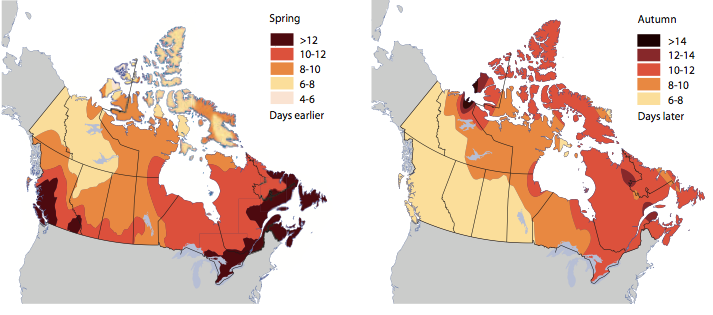
to 2069 (SWIPA, 2011). Click for larger image.
The air temperature within the Arctic is predicted to continue along a warming trend, and the altitude of the freezing point (0°C isotherm) is expected to elevate. These factors have extensive controls on seasonality and duration of lake ice in the Arctic. As temperatures increase in the future, duration of ice-free season will increase, with some lakes remaining ice-free perennially. However, the reaction of lakes to future climate states is a function of their geographic position, with many varying responses throughout the circumpolar north. Moreover, lakes at relatively southern positions have been revealed to exhibit more pronounced changes than higher latitude lakes.
Few long term lake records are available, however, those available in the Northern Hemisphere indicate that freeze-up of lake ice is progressively occurring later (10.7 days per century), break-up of lake ice is occurring sooner (8.8 days per century) and overall duration of ice cover has decreased (17.4 days per century). These trends have intensified during the last couple decades. Generally, it is predicted that trends in lake ice freeze and break-up are a function of temperature such that a five-day change will occur with every long-term degree change in temperature. In particular, temperature alterations in the seasons preceding winter freeze (summer and autumn) of lakes has a 60-70% chance of being the reason for variation, rather than the winter season itself. It is predicted that the 0°C isotherm will occur more than 12 days earlier in spring and more than 14 days later in the fall in some regions of the Arctic within the next few decades (Figure 1). This result would have extensive influences on Arctic lake ice regime and seasonal conditions of freshwater ice in the circumpolar north (SWIPA: Prowse, et al., 2011).

(b) 50°N, (c) 60°N, and (d) 70°N latitudes during the
seasonal periods of 1960-1999 and 2040-2079
(Dibike et al., 2011). Click for larger image.
Dibike et al. predict noticeable changes in Arctic lake temperature profiles within this century (Figure 2). An overall increase in mean lake temperature for the fall, spring and summer seasons is expected across the circumpolar Arctic. Additionally, southern lakes will possibly experience a more pronounced change with temperature increases reaching 2-5°C. In contrast, though northern lakes are expected to experience temperature increases, the changes will be less prominent. With the changes in climate, fall mixing processes within lake systems will be deferred. For this reason, mid-depth temperatures may experience a slight decrease during this season. Moreover, in the winter season a small decrease in temperature is also expected, with reduced snowfall reducing insolation capabilities (Dibike et al., 2011).
Material on this page was provided by Maren Pauly, Department of Geography, University of Waterloo.
